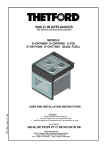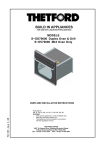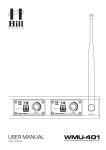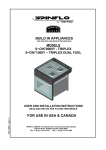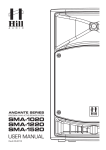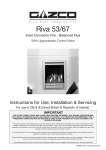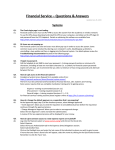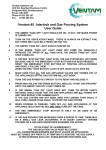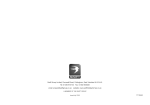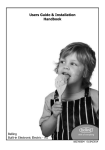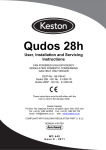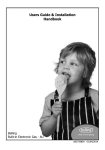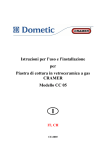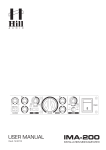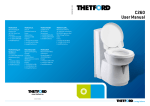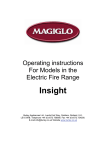Download PCC1272_Topline_Issue 7_GB_270611
Transcript
BUILD-IN COOKING HOB FOR USE WITH LIQUIFIED PETROLEUM GAS TOPLINE HOB INSET SERIES 160, 162, 164, 167 TOP MOUNT SERIES 910, 920, 922, 930, 960 PCC 1272– Issue 7 - GB USER AND INSTALLATION INSTRUCTIONS READ AND RETAIN FOR FUTURE REFERENCE FOR USE IN: GB, IE, FR, NL, BE, LU, ES, IT, NO, DE, DK, SE THETFORD LIMITED, 19 Oakham Drive, Parkwood Industrial Estate Rutland Road, Sheffield S3 9QY, ENGLAND. TEL: + 44 (0) 114 273 8157 FAX: + 44 (0) 114 275 3094 2 3 4 CONTROL POSITIONS – ALL MODELS FIG. 1 OFF FULL RATE LOW RATE APPLIANCE LOCATION For either Inset or Top mounted appliances the minimum allowable distance to combustible materials is as shown below. FIG. 2 A = 200mm unless Protected by a Non-combustible heat barrier B = 500mm minimum to fitment above appliance 5 FIG. 3 Series 160 – Worktop cutout for flush mount seal Series 160 – Worktop cutout for surface mount seal = Intersection of radi points 6 FIG. 4 Series 167 worktop cutout details Series 164 worktop cutout details 7 WORKTOP CUTOUT DETAILS FIG. 5 8 WORKTOP CLAMPING METHODS FIG. 6 SERIES 160, 162, 164 & 167 INSET HOBS (Top Mount Seal) FIG. 7 SERIES 160,162,164 & 167 INSET HOBS (Flush Mount Seal) FIG. 8 SERIES 910, 920, 921, 922, 930 & 960 HOBS (Hidden Seal) 9 INTRODUCTION GB This appliance is designed for cooking food, any other use is incorrect and dangerous. Failure to install the appliance correctly or improper use could invalidate any warranty or liability claims and lead to prosecution. This appliance must be installed in accordance with the local, national and European regulations in force. Particular attention shall be given to the requirements regarding ventilation. Read the instructions before installing or using the appliance. The appliance MUST be installed by an approved competent person. Our policy is one of continuous development and improvement. Specifications and illustrations may change subsequent to publication. Provision of Ventilation The use of a gas cooking appliance results in a production of heat and moisture in a room in which it is installed. Ensure that the kitchen is well ventilated: keep natural ventilation holes open or install a mechanical ventilation device, (mechanical extractor hood). Prolonged intensive use of the appliance may call for additional ventilation, for example opening a window, or more effective ventilation, for example increasing the level of mechanical ventilation where present. The room containing the cooker should have an air supply in accordance with local and national/European standards. Position This appliance must be positioned free from draughts, which may affect the combustion, and in a manner that will prevent the accumulation of unburnt gas. When in use ensure that air vents are not inadvertently blocked or shut off. Appliance should only be used with Liquefied Petroleum Gas (LPG) Use only the Gas Pressures specified This appliance MUST be earthed • • • OPERATION The burners on the appliance have fixed aeration and no adjustment is required. The burners should flame as follows:Propane The flames should burn quietly with a blue/green colour with no sign of yellow tips. Butane Normally on initial lighting, a small amount of yellow tipping will occur and then slightly increases as the burner heats up. The burners are controlled individually and each is monitored by a thermocouple probe. In the event the burner flames are accidentally extinguished, turn off the burner control and do not attempt to re-ignite the burner for at least one minute • • • When cooking, young children should be kept away. Glass lids may shatter when heated. Turn off all burners before shutting the lid. Take care when closing the lid as the travel lock action of the hinges activates towards the end of lowering the lid. 10 OPERATION GB 1. Ensure gas supply is connected and turned on. 2. Push in the control knob and turn anticlockwise to full rate – large flame ( ) Fig. 1. 3. Continue holding the knob depressed whilst the automatic ignition lights the burner. For manual models hold a lighted match or taper to the burner. 4. After the burner is lit continue depressing the knob for approximately 10 - 15 seconds. 5. Release knob and turn to required heat setting – see Fig. 1. 6. If burner has not lit within 15 seconds, release knob and wait at least 1 minute before repeating operations (2) to (5). 7. To turn off, rotate the control knob until the line on the knob is aligned with dot on the control panel. Always make sure the control knob is in the off position when you have finished using the hotplate burners. DO'S AND DON'TS DO Read the user instructions carefully before using the appliance for the first time. DO Allow the burners to heat before using for the first time, in order to expel any smells before the introduction of food. DO Clean the appliance regularly. DO Remove spills as soon as they occur. DO Check that controls are in the off position when finished. DO NOT Allow children near the appliance when in use. Turn pan handles away from the front so that they cannot be caught accidentally. DO NOT Allow fats or oils to build up in the base of the hotplate. DO NOT Use abrasive cleaners or powders that will scratch the surfaces of the hotplate. DO NOT Under any circumstances use the appliance as a space heater. LEAKS If a smell of gas apparent, the supply should be turned off at the cylinder IMMEDIATELY. Extinguish naked lights including cigarettes and pipes. Do not operate electrical switches. Open all doors and windows to disperse any gas escape. Butane/Propane gas is heavier than air; any gas escaping will therefore collect at low level. The strong unpleasant smell of gas will enable the general area of the leak to be detected. Check that the gas is not escaping from an unlit appliance. Never check for leaks with a naked flame; leak investigation should be carried out using a leak detector spray or soapy solution. MAINTENANCE & SERVICING This appliance needs little maintenance other than cleaning. All parts should be cleaned using warm soapy water. Do not use abrasive cleaners, steel wool or cleansing powders. When cleaning the burner ring it is essential to ensure that the holes do not become blocked. The control knobs are a push fit and can be removed for cleaning. They are interchangeable without affecting the sense of operation. ALL SERVICING MUST BE CARRIED OUT BY AN APPROVED COMPETENT PERSON. AFTER EACH SERVICE THE APPLIANCE MUST BE CHECKED FOR GAS SOUNDNESS. 11 INSTALLATION GB In your own interest of safety, it is law that all gas appliances be installed by an approved competent person who will undertake to work to safe and satisfactory standards. Failure to install the appliance correctly could invalidate any warranty or liability claims and lead to prosecution. This appliance shall be installed in accordance with the local and national/European standards in force. Particular attention shall be given to the requirements regarding ventilation. Read the instructions before installing or using this appliance. VENTILATION This appliance is suitable for installation into Holiday Homes, Touring Caravans and Boats. In all cases the national standards with regard to ventilation for the particular vehicle into which the appliance is to be installed must be adhered to. The appliance MUST have a gas escape hole (min size 50mm Ø; max 70mm Ø; or shaped hole of equivalent area – 1965 to 3850mm2 ) in the floor, directly beneath the appliance. The hole MUST vent to the outside. LOCATION OF APPLIANCE This appliance maybe installed in a kitchen/kitchen diner but NOT in a room containing a bath or a shower. LP gas appliances must not be fitted below ground level. e.g. in a basement. POSITION The performance of the appliance meets the requirements of the European Standard for Domestic Cooking Appliances (EN30) which specifies a maximum allowable temperature rise of the furniture into which the appliance is installed of 65oC above the ambient temperature. To ensure compliance with the standard it is important the installation follows the dimensions as shown in this manual. A cutout should be prepared – see Figs. 3,4 & 5 for model and details. The location of the cutout MUST comply with Fig. 2 after the hob is installed – ie a direct distance of 200mm must exist between the edge of the burner and combustible material unless protected by a layer of noncombustible material. The appliance should be fixed in place using the supplied clamps – see Figs. 6, 7 & 8 for model type and clamping method. For models with a glass lid, the distance from the edge of the burner to the rear wall can be reduced to 110mm. All combustible materials such as curtains and shelves must be kept well clear of the appliance. Any fitments such as a cupboard above the appliance must have a minimum clearance of 500mm between the fitment and the top of the pan support. This appliance must be positioned free from draughts, which may affect the combustion, and in a manner that will prevent the accumulation of unburnt gas. When in use ensure that air vents are not inadvertently blocked or shut off. We recommend the underside of the hob be shielded particularly if this area is to be used for storage or the installation of another appliance. The shield should be fabricated from non-combustible material, but if the enclosure is manufactured from combustible material there should be a minimum distance of 120mm between the worktop (top face) and the shield. THIS AIR SPACE MUST BE WELL VENTILATED 12 INSTALLATION GB On completion of the installation a warning notice complying to EN721 Annex A should be affixed adjacent to the appliance. If other appliance/s are located below the hob we recommend conducting a temperature verification test to confirm any rise in temperature of the cabinet materials are within allowable limits and meet requirements specified in EN30-1-1, EN1949, EN1645-1, EN1646-1, EN1647, EN721. Gas Connection Prior to connection ensure the local conditions for gas type and gas pressure match the appliance specification. (Gas type and pressure for this appliance are printed on the databadge located on the base of appliance) The Ø8mm gas inlet is located to the rear of the appliance. Prior to connection remove the plastic protection plug from the fitting. The appliance MUST be connected using metal pipe manufactured from either copper, seam welded steel, seamless steel or stainless steel, which complies to the requirements of EN1949, rubber tubing MUST NOT be used. • • • Where Spark Ignition is fitted the appliance MUST be earthed After Installation the appliance MUST be tested for soundness The gas supply input pressure to which this appliance is connected, MUST not rise or fall by more than 2.5 mbar (butane/propane) from nominal when ALL appliances connected to the supply are OPERATED simultaneously. If this appliance is not installed in accordance with the instructions and tolerances detailed herein, we the manufacturer can not be held responsible for any problems that occur, or poor performance that is perceived/witnessed. 13














